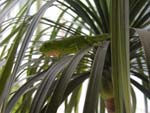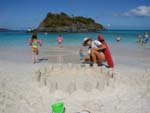 |
 | |
  | |
|
|
|
|
Virgin Islands National Park
For Kids
|
|
|
|
|
|
 |
 |
|
COMING FOR A VISIT TO VIRGIN ISLANDS NATIONAL PARK?
The Park is a great place for kids!
|
 |
| NPS | |
 |
While visiting Virgin Islands National Park, don’t forget to stop in the Park's Visitor Center at Cruz Bay. Ask a Ranger at the desk how you can become a Junior Ranger. After completing the requirements, you’ll be awarded the Junior Ranger program certificate and badge; what a nice accomplishment!
|
 |
| NPS | |
 |
The exhibits at the Visitor Center are big and colorful. Maybe your favorite will be about coral. Everyone likes to look at the 3-D map on a large table. Watch out! Dolphins are watching you from the ceiling!
|
 |
| NPS | |
 |
In the Visitor Center there’s a small store operated by Eastern National. Eastern National provides educational products that are relevant to the theme of the park. There are post cards, kids' books and toy animals. Another store, operated by the Friends of Virgin Islands National Park, is just a short walk away from the Visitor Center, at Mongoose Junction. Either store might have just the right souvenir for you to buy to help remind you of your visit to the Park.
|
 |
| NPS | |
 |
Of course the best part of a visit to Virgin Islands National Park is being OUTDOORS! Among other things, we have lots of plants and animals that you probably don't have in your backyard. This camouflaged lizard is probably a young iguana.
|
 |
| NPS | | Taino petroglyph |
 |
You can learn about people who lived in the Virgin Islands long ago. There are 200-year-old ruins from Danish overseers and enslaved Africans. Even older petroglyphs made by the ancient Taino are hidden in the forest.
|
 |
| NPS | |
 |
Oops! If you trip over a rock, it was probably made by the volcano that started building the island about 100 MILLION years ago. Wow; that was during dinosaur time! (Sorry, no dinosaurs ever lived on the Virgin Islands.) See that almost level layer of rock below the reddish rock? It might be what's called a "sill," caused by newer lava pushing into a crack in older rock.
|
 |
| NASA | |
 |
Virgin Islands National Park, like many National Parks, has dark night skies. When your eyes adapt to the darkness, you may see the Milky Way and stars that you don't see at home. This picture shows the Southern Cross constellation, visible in our night skies during busy visitor seasons.
|
 |
| NPS | |
 |
The Virgin Islands National Park is known for beautiful beaches. You can swim in turquoise water, explore coral reefs & sea grasses by snorkeling, and build castles in the sand.
|
LOOKING FOR ONLINE ACTIVITIES?
If you can’t come to Virgin Islands National Park, or if you want to learn more about the Park before you come, perhaps you’d like to check out our Park Fun; it links to online activities especially for kids, like...
Online Snorkel Trips.
|
|  |

|
 |
|
|
|
|
|
 |
|
Did You Know?
The mangrove forests found along the coastline in some bays serve as nursery habitats for juvenile fish. These beautiful trees with aerial roots provide filtration of the runoff and reduce the amount of sediment reaching the ocean. The Red Mangrove is one of several species found in the Park.
|
|
|
|
Last Updated: February 24, 2008 at 17:09 EST |






